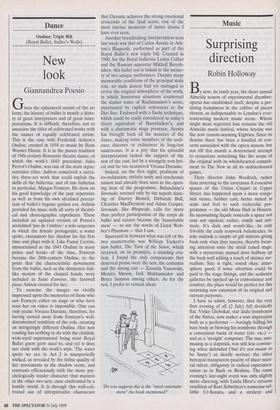Dance
. Ondine; Triple Bill (Royal Ballet, Sadler's Wells)
New look
Giannandrea Poesio
Given the ephemeral nature of the art form, the history of ballet is mostly a histo- ry of great interpreters and of great inter- pretations. It is difficult, therefore, not to associate the titles of celebrated works with the names of equally celebrated artists. This is the case with Frederick Ashton's Ondine, created in 1958 to music by Hans Werner Henze. It is in the purest tradition of 19th-century Romantic theatre dance, of which the work's 1843 precedent, Jules Perrot's Ondine, was one of the most repre- sentative titles. Ashton conceived a narra- tive three-act work that could exploit the skills of the ballerina, and of one ballerina in particular, Margot Fonteyn. He drew on his good knowledge of the past repertoire as well as from his own idealised percep- tion of ballet's bygone golden era. Ashton provided his muse with all sorts of theatri- cal and choreographic expedients. These included an updated version of Perrot's acclaimed 'pas de l'ombre': a solo sequence in which the female protagonist, a water sprite, encounters her shadow for the first time and plays with it. Like Fanny Cerrito, immortalised as the 1843 Ondine in many prints and books of the time, Fonteyn became the 20th-century Ondine, to the point that the characteristic movements from the ballet, such as the distinctive fish- like motion of the clasped hands, were included in Salut d'amour, the farewell piece Ashton created for her.
To exorcise the images so vividly impressed upon the memories of those who saw Fonteyn either on stage or who have seen her on video is impossible. One can only praise Viviana Durante, therefore, for having moved away from Fonteyn's well- documented rendition of the role, creating an intriguingly different Ondine. Her new reading has nothing to do with the childish, wide-eyed supernatural being most Royal Ballet goers grew used to, and yet it does not clash with the work's style. The water sprite we see in Act I is unexpectedly wicked, as revealed by the feline quality of her movements in the shadow scene, and contrasts efficaciously with the more psy- chologically tender character that matures in the other two acts, once confronted by a hostile world. It is through this well-cali- brated use of interpretative chiaroscuro that Durante achieves the strong emotional crescendo of the final scene, one of the most intense moments of dance drama I have ever seen.
Another breathtaking interpretation seen last week was that of Carlos Acosta in Ash- ton's Rhapsody, performed as part of the Royal Ballet's new triple bill. Created in 1980, for the Royal ballerina Lesley Collier and the Russian superstar Mikhail Barysh- nikov, this ballet too is linked to the memo- ry of two unique performers. Despite many memorable renditions of the principal male role, no male dancer had yet managed to revive the original atmosphere of the work, in which humorous situations counteract the darker tones of Rachmaninov's score, punctuated by explicit references to the Dies Irae. Endowed with a flashy technique, which could be easily considered as today's direct equivalent of Baryshnikov's, and with a charismatic stage presence, Acosta has brought back all the nuances of the dance, making some members of the audi- ence discover or rediscover its long-lost undertones. It is a pity that his splendid interpretation lacked the support of the rest of the cast, led by a strangely non-lyri- cal and far too mannered Viviana Durante.
Indeed, on the first night, problems of co-ordination, stylistic unity and synchronic unison had already been seen in the open- ing item of the programme, Balanchine's Serenade, rescued only by the superb danc- ing of Darcey Bussell, Deborah Bull, Christina MacDermott and Adam Cooper. Serenade, like Rhapsody, calls for more than perfect participation of the corps de ballet and cannot become the 'lamentable mess' — to use the words of Lloyd Web- ber's Phantom — that I saw.
Squeezed in between what was left of the two masterworks was William Tuckett's new ballet, The Turn of the Screw, which received, on its premiere, a standing ova- tion. I found the only components that deserved praise were the sets, the costumes and the strong cast — Zenaida Yanowsky, Monica Mason, Irek Mukhamedov and Bruce Samson among others. As for the rest, I prefer to remain silent.
Do you suppose this is the "street entertain- ment" the book mentioned?'


























































 Previous page
Previous page